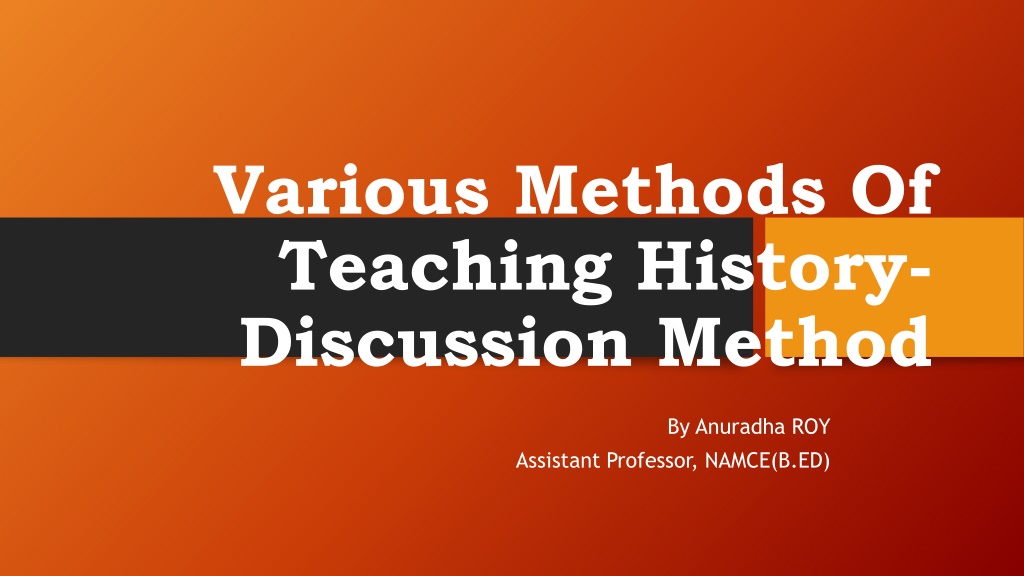
Effective Discussion Methods in Teaching History
Discover the various methods and essential elements of using discussion as a teaching tool in history classes. Explore the merits and limitations of discussions, along with techniques for organizing engaging classroom dialogues, as outlined by Assistant Professor Anuradha Roy.
Download Presentation

Please find below an Image/Link to download the presentation.
The content on the website is provided AS IS for your information and personal use only. It may not be sold, licensed, or shared on other websites without obtaining consent from the author. If you encounter any issues during the download, it is possible that the publisher has removed the file from their server.
You are allowed to download the files provided on this website for personal or commercial use, subject to the condition that they are used lawfully. All files are the property of their respective owners.
The content on the website is provided AS IS for your information and personal use only. It may not be sold, licensed, or shared on other websites without obtaining consent from the author.
E N D
Presentation Transcript
Various Methods Of Teaching History- Discussion Method By Anuradha ROY Assistant Professor, NAMCE(B.ED)
Meaning & Significance Discussion has been described as a thoughtful consideration of the relationship involved in a topic or problem under study. It is concerned with the analysis, comparison of the relationship. It aims at uniting and integrating the work of class. It encourages the students to direct their thinking process towards the solution of a problem and to use their experience for a further clarification and consolidation of learning material.
Essential Elements of Discussion Method Discussion is very important in stimulating mental activity, developing fluency and ease of expression , clarity of ideas in thinking and training in the presentation of one s ideas and facts.An exchange of ideas and opinions offers valuable training to students in reflective thinking. 1. The facilitator- Teacher 2. The group- Students 3. The Problem/ The Topic 4. The Content- body of knowledge 5. Evaluation
Merits of Discussion It helps in clarifying issues It helps students in discovering what they do not know and what they have overlooked It helps students in discovering what they do not know and what they have overlooked It engenders more reflection . It is farther from rote learning It represents a type of pooled knowledge, ideas, and feelings of several persons. It develops team spirit It helps the teacher in discovering talented students who have potential for becoming good leaders It provides opportunities to the students to speak distinctly, stand and sit correctly, respect ideas of others , share interests, ask pertinent questions and comprehend the problem before the group It affords opportunities to the students to learn together, make suggestions, share responsibility, comprehend the topic, evaluate the findings and to summarise the results.
Limitations of Discussion It is not suitable in all topics It is likely to be dominated by a few students It is likely to go off the track It may lead to unpleasant feelings It may create emotional tensions It may involve unnecessary arguments
Techniques of Organising a Discussion By A Teacher Introducing a topic or a problem by the teacher by giving points or explanation to serve as the basis of discussion Calling upon a pupil by the teacher to give facts, describe a scene or situation, explain an incident, event or happening for getting the discussion started. Preparing an outline of points co-operatively by the teacher and a few students which may become the starting point of discussion. Asking the students to describe their own experience connected with the subject or the topic or the problem Presenting detailed papers by the students and teachers and discussing them in the class Showing special papers and pictures, charts diagrams and projects and discussing them in the class.
Role of Teacher to Direct The Group-Discussions Students should be well acquainted with the significance of the topic its nature and scope and reasons why the class should discuss it. Discussions should be confined to important aspects. Students should be encouraged to participate in the discussion Ideas may be invited without pressure and embarrassment Explanations, where needed, should be provided Co-operation is needed than Competition Efforts should be made to develop team spirit. Doubts , mistakes and wrong interpretations should be cleared by the teacher Facts and points should be summarised and evaluated Only a few students are not allowed and shy students may be given training for removing their hesitation.
